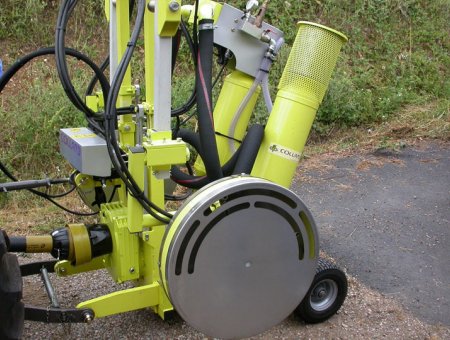Blower leaf remover
Blower de-leafers are sophisticated viticultural tools that use a stream of compressed air to shred the leaves without damaging the bunches. This airflow, produced by a compressor and distributed by rotating nozzles, ensures efficient leaf removal.
Their use during flowering and after veraison ensures precise and safe foliage management.
Their use during flowering and after veraison ensures precise and safe foliage management.

Feeding
The blower leaf remover is powered by a compressor that generates a stream of compressed air. this discontinuous flow of air, directed towards the foliage, shreds the leaf blade. The compressor can either be integrated into the machine itself, or supplied by the tractor to which the leaf remover is attached. The compressed air is then directed towards rotating nozzles which disperse the air in powerful, discontinuous jets, capable of shredding the leaves without touching the bunches.Attachment
The leaf blower is generally attached to the front or rear of a tractor, depending on the model. Rear hitching is more common, but some models are designed for front use, giving the operator better visibility and manoeuvrability. The hitch system includes sturdy, secure attachments to guarantee the stability of the equipment during operation.Setting
The blower leaf remover has several adjustment options to suit different vineyard conditions:Jet pressure
The pressure of the compressed air can be adjusted according to the thickness and density of the foliage. A higher pressure is used for dense foliage, while a lower pressure is suitable for lighter foliage.Nozzle tilt
The rotating nozzles can be tilted to direct the air flow precisely onto the leaves to be removed. Theangle of tilt is adjustable to effectively target specific areas of foliage.Nozzle rotation speed
The speed at which the nozzles rotate can be adjusted to optimise air distribution. Fast rotation is used for more uniform coverage, while slower rotation allows more precise work.Control
Operating a blower leaf remover requires a certain amount of skill and care on the part of the operator. Here are the typical stages of operation:Installation and preparation
Before starting, the operator attaches the leaf remover to the tractor and makes the initial pressure and tilt adjustments. The compressor is checked to ensure that it is operating correctly.Positioning
The tractor is positioned to align the remover with the rows of vines. The operator must ensure that the equipment is well centred to avoid any contact with the bunches.Operation
Once in place, the operator starts the compressor and adjusts the speed of the tractor to ensure uniform coverage. Settings can be adjusted en route to take account of variations in foliage density.Safety
The protective casing around the nozzles ensures that there is no direct mechanical contact with the bunches, minimising the risk of injury to the fruit. The operator must also monitor the machine for any signs of blockage or malfunction.Advantages
Blower removers are highly valued for their efficiency and safety. They are particularly useful during flowering and after veraison, as they do not damage the bunches. What's more, they help to remove flower caps at the end of flowering, improving the quality of the harvest.In short, a blower leaf remover is an indispensable winegrowing tool, combining precision, safety and efficiency thanks to a well-designed and easily adjustable compressed air flow system.












